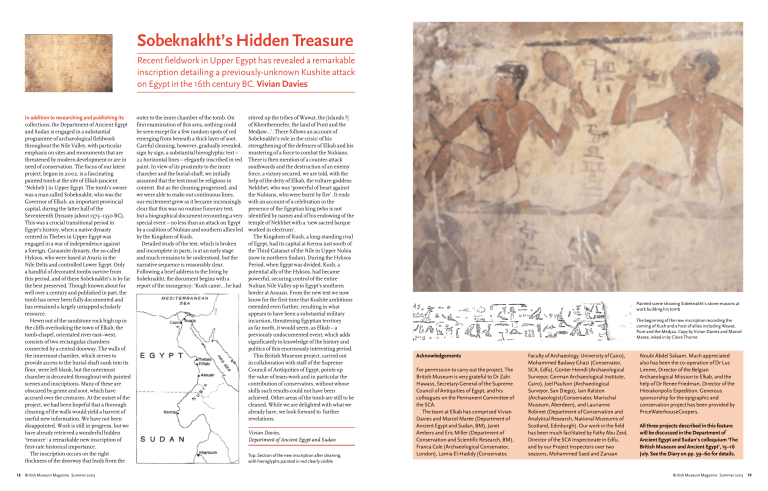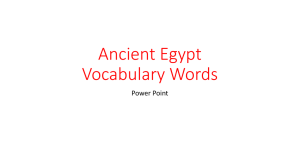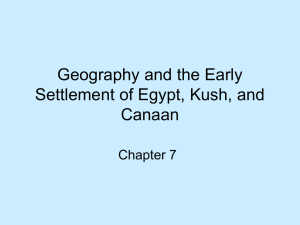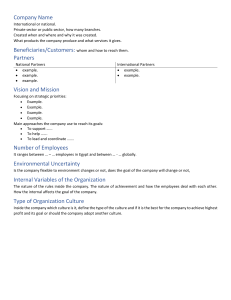
Sobeknakht’s Hidden Treasure Recent fieldwork in Upper Egypt has revealed a remarkable inscription detailing a previously-unknown Kushite attack on Egypt in the 16th century BC. Vivian Davies In addition to researching and publishing its collections, the Department of Ancient Egypt and Sudan is engaged in a substantial programme of archaeological fieldwork throughout the Nile Valley, with particular emphasis on sites and monuments that are threatened by modern development or are in need of conservation. The focus of our latest project, begun in 2002, is a fascinating painted tomb at the site of Elkab (ancient ‘Nekheb’) in Upper Egypt. The tomb’s owner was a man called Sobeknakht, who was the Governor of Elkab, an important provincial capital, during the latter half of the Seventeenth Dynasty (about 1575–1550 BC). This was a crucial transitional period in Egypt’s history, when a native dynasty centred in Thebes in Upper Egypt was engaged in a war of independence against a foreign, Canaanite dynasty, the so-called Hyksos, who were based at Avaris in the Nile Delta and controlled Lower Egypt. Only a handful of decorated tombs survive from this period, and of these Sobeknakht’s is by far the best preserved. Though known about for well over a century and published in part, the tomb has never been fully documented and has remained a largely untapped scholarly resource. Hewn out of the sandstone rock high up in the cliffs overlooking the town of Elkab, the tomb-chapel, orientated river east–west, consists of two rectangular chambers connected by a central doorway. The walls of the innermost chamber, which serves to provide access to the burial-shaft sunk into its floor, were left blank, but the outermost chamber is decorated throughout with painted scenes and inscriptions. Many of these are obscured by grime and soot, which have accrued over the centuries. At the outset of the project, we had been hopeful that a thorough cleaning of the walls would yield a harvest of useful new information. We have not been disappointed. Work is still in progress, but we have already retrieved a wonderful hidden ‘treasure’: a remarkable new inscription of first-rate historical importance. The inscription occurs on the right thickness of the doorway that leads from the 18 British Museum Magazine Summer 2003 outer to the inner chamber of the tomb. On first examination of this area, nothing could be seen except for a few random spots of red emerging from beneath a thick layer of soot. Careful cleaning, however, gradually revealed, sign by sign, a substantial hieroglyphic text – 22 horizontal lines – elegantly inscribed in red paint. In view of its proximity to the inner chamber and the burial-shaft, we initially assumed that the text must be religious in content. But as the cleaning progressed, and we were able to make out continuous lines, our excitement grew as it became increasingly clear that this was no routine funerary text, but a biographical document recounting a very special event – no less than an attack on Egypt by a coalition of Nubian and southern allies led by the Kingdom of Kush. Detailed study of the text, which is broken and incomplete in parts, is at an early stage and much remains to be understood, but the narrative sequence is reasonably clear. Following a brief address to the living by Sobeknakht, the document begins with a report of the insurgency: ‘Kush came… he had stirred up the tribes of Wawat, the [islands ?] of Khenthennefer, the land of Punt and the Medjaw…’. There follows an account of Sobeknakht’s role in the crisis: of his strengthening of the defences of Elkab and his mustering of a force to combat the Nubians. There is then mention of a counter-attack southwards and the destruction of an enemy force, a victory secured, we are told, with the help of the deity of Elkab, the vulture-goddess Nekhbet, who was ‘powerful of heart against the Nubians, who were burnt by fire’. It ends with an account of a celebration in the presence of the Egyptian king (who is not identified by name) and of his endowing of the temple of Nekhbet with a ‘new sacred barque worked in electrum'. The Kingdom of Kush, a long-standing rival of Egypt, had its capital at Kerma just south of the Third Cataract of the Nile in Upper Nubia (now in northern Sudan). During the Hyksos Period, when Egypt was divided, Kush, a potential ally of the Hyksos, had became powerful, securing control of the entire Nubian Nile Valley up to Egypt’s southern border at Assuan. From the new text we now know for the first time that Kushite ambitions extended even further, resulting in what appears to have been a substantial military incursion, threatening Egyptian territory as far north, it would seem, as Elkab – a previously undocumented event, which adds significantly to knowledge of the history and politics of this enormously interesting period. This British Museum project, carried out in collaboration with staff of the Supreme Council of Antiquities of Egypt, points up the value of team-work and in particular the contribution of conservators, without whose skills such results could not have been achieved. Other areas of the tomb are still to be cleaned. While we are delighted with what we already have, we look forward to further revelations. Vivian Davies, Department of Ancient Egypt and Sudan Top: Section of the new inscription after cleaning, with hieroglyphs painted in red clearly visible Painted scene showing Sobeknakht's stone-masons at work building his tomb The beginning of the new inscription recording the coming of Kush and a host of allies including Wawat, Punt and the Medjau. Copy by Vivian Davies and Marcel Maree, inked in by Claire Thorne Acknowledgements For permission to carry out the project, The British Museum is very grateful to Dr Zahi Hawass, Secretary-General of the Supreme Council of Antiquities of Egypt, and his colleagues on the Permanent Committee of the SCA. The team at Elkab has comprised Vivian Davies and Marcel Marée (Department of Ancient Egypt and Sudan, BM), Janet Ambers and Eric Miller (Department of Conservation and Scientific Research, BM), Franca Cole (Archaeological Conservator, London), Lamia El-Hadidy (Conservator, Faculty of Archaeology, University of Cairo), Mohammed Badawy Ghazi (Conservator, SCA, Edfu), Günter Heindl (Archaeological Surveyor, German Archaeological Institute, Cairo), Joel Paulson (Archaeological Surveyor, San Diego), Iain Ralston (Archaeologist/Conservator, Marischal Museum, Aberdeen), and Laurianne Robinet (Department of Conservation and Analytical Research, National Museums of Scotland, Edinburgh). Our work in the field has been much facilitated by Fathy Abu Zeid, Director of the SCA Inspectorate in Edfu, and by our Project Inspectors over two seasons, Mohammed Saed and Zanaan Noubi Abdel Salaam. Much appreciated also has been the co-operation of Dr Luc Limme, Director of the Belgian Archaeological Mission to Elkab, and the help of Dr Renee Friedman, Director of the Hierakonpolis Expedition. Generous sponsorship for the epigraphic and conservation project has been provided by PriceWaterhouseCoopers. All three projects described in this feature will be discussed in the Department of Ancient Egypt and Sudan’s colloquium ‘The British Museum and Ancient Egypt’, 15–16 July. See the Diary on pp. 59–60 for details. British Museum Magazine Summer 2003 19



